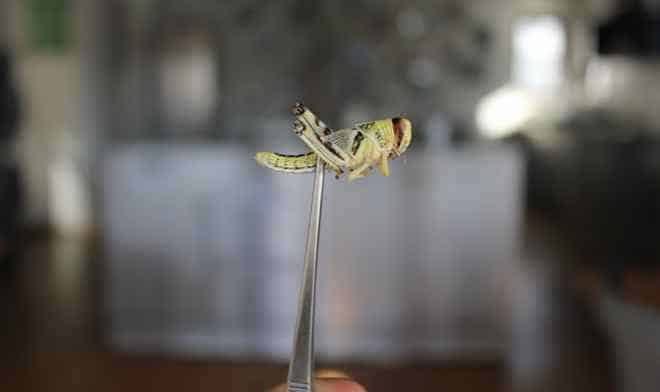In 2013, the U.N. Food and Agriculture Organization (FAO) issued a report proposing edible insects as a viable alternative for food and feed security both in developed and developing countries.
The idea of eating insects may be a challenging idea for many. Psychologist and Professor Paul Rozin explains that in Western societies, insects do not readily enter the category of edible—instead they are an object of dislike and disgust. In other parts of the world, insects form an important part of edible diversity: crispy fried locusts in Thailand, delicate ant larvae in Mexico, and raw termites in Uganda are only a few ways that the recorded 1,900 edible species are enjoyed.
Nutritionally, insects can be good source of protein, minerals, vitamins, fatty acids and fiber, especially in relation to conventional livestock. For example, the omega 3 fatty acid contained in mealworms is comparable to that in fish. And the iron content in mopane caterpillars varies from 31–77 mg per 100 g of dry weight versus only six mg per 100 g of dry weight in beef. For the environment, they can present a series of benefits such as reduced land and water requirements, low GHGs emissions, little risk of zoonotic infections, and fewer problems with animal welfare issues.
Many public and private sectors across the globe are harnessing these opportunities. In the European Union, black soldier fly larvae is being researched for fish and poultry feed. PROteINSECT, funded by the EU government, is working on policy changes for insect feed (which, at the moment, is only permitted for fish and shellfish) and evaluating the safety of the larvae along with taste and texture of the meat produced.
As human food, insects present versatile applications; insects can be processed into a range of items such as energy bars, meat substitutes, and enriched flours. For example, Aaron T. Dossey, a biochemist supported by the USDA’s SBIR grant, has developed a technology to produce nutrient rich insect flour, which according to Dossey is “superior in flavor and texture.”
Robert Nathan Allan, co- founder of Little Herds, an insect education non-profit based in Austin, Texas, explains that many people reevaluate the way they think about insects when presented with sustainable arguments and a friendly tasting menu “In Austin, we’ve served over 3,000 people in the last few months, and every single one has said, ‘I’d eat that’.”
In many developing countries where insects already have a respected place in the local market, entomophagy presents many opportunities. GREENiNSECT, a food security project, is investigating implementation of small and large scale insect industries throughout Kenya. Simultaneously in Mexico a grassroots cooperative, Teotlacualli Farm, is collectively harvesting endemic species of insects (such as Maguey worms and ant larvae).
In May 2014, the FAO and Wageningen University Research Centre will hold a conference, which will bring together the food and feed industries, government officials, and academia in order to consolidate a framework to promote further development of this sector.










